Alaska Bear Tours: Why Alaska Homestead Lodge is worth the money – but also visit Brooks and Wolverine Creek
Published on: October 22, 2025 | Last Updated: October 22, 2025
In July 2025 I took a group to Alaska for what was our third Alaska bear viewing small group tour run by Wildlife Trails. We stayed for a total of 3 weeks, and visited Alaska Homestead Lodge in Lake Clark National Park, followed by wildlife and glacier tours out of Seward, a Brooks Falls bear viewing tour from Homer, a Seldovia wildlife cruise from Homer, and finally a Wolverine Creek bear viewing tour from Kenai/Nikiski. It was an amazing experience for getting up close and personal to the bears, but as always with Alaska wildlife holidays we learnt a lot about the ground realities and which of these Alaska bear safaris really delivered as a photographic experience.
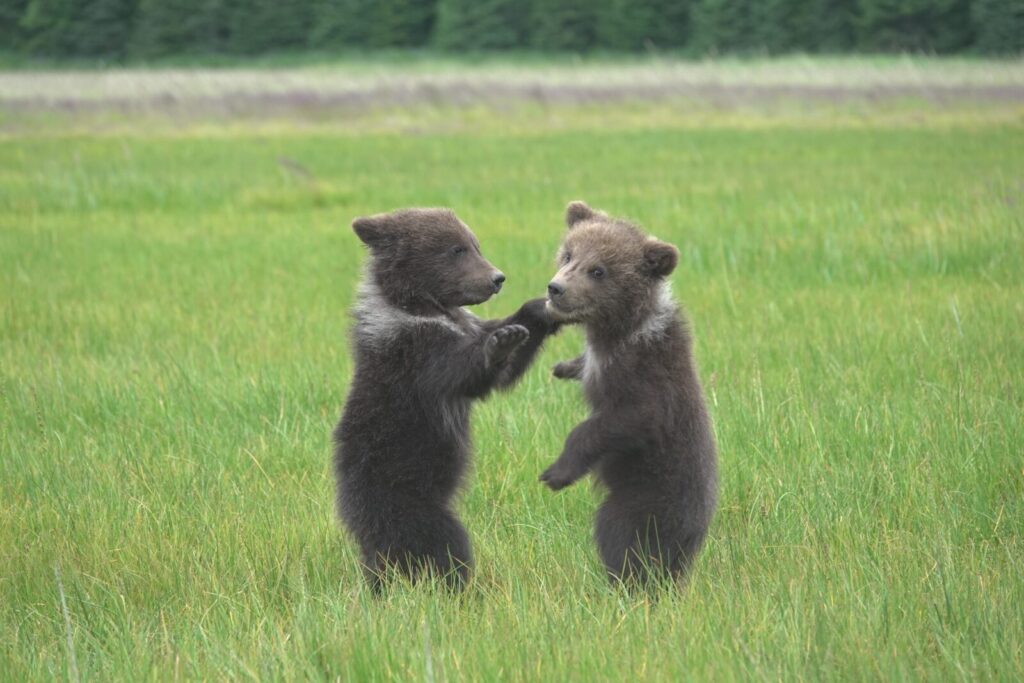
What makes bear viewing in Lake Clark National Park so special?
First up I should quantify that statement as spending 5 nights at the amazing Alaska Homestead Lodge is a very different experience than simply flying in from Anchorage or Susitna for 1 or 2 hours to watch bears. Yes, Lake Clark national park is open to all visitors, so in some ways you might think why would I book an Alaska bear safari at a ‘fly-in’ wilderness lodge that does not give me exclusive access to the bears? It’s a fair question as the cost of all bear viewing lodges in Alaska are very expensive so quite rightly people’s expectations are high. Add to that the consensus that the bear viewing in Alaska is the best in the world, when you book an Alaska wildlife holiday you want your stay at the bear viewing lodge to be the crown in the jewel of your time in this unique and wild far north state.
The first point to make is the bear viewing at Alaska Homestead Lodge is intense and 100% you get your money’s worth when you consider the amount of time spent in the field photographing and observing bears. Our standard routine was out from 06:00 to 08:00, back for breakfast and then out again from 09:30 until just after 12pm. Then a long afternoon session from 2 to 6pm before a final night session from 8 to 10pm. That’s up to 10 hours of bear viewing in Lake Clark National Park and since the best time to visit is the summer when you don’t lose the light until close to midnight, you can see why a stay at Alaska Homestead Lodge is on the wish list of many photographers.
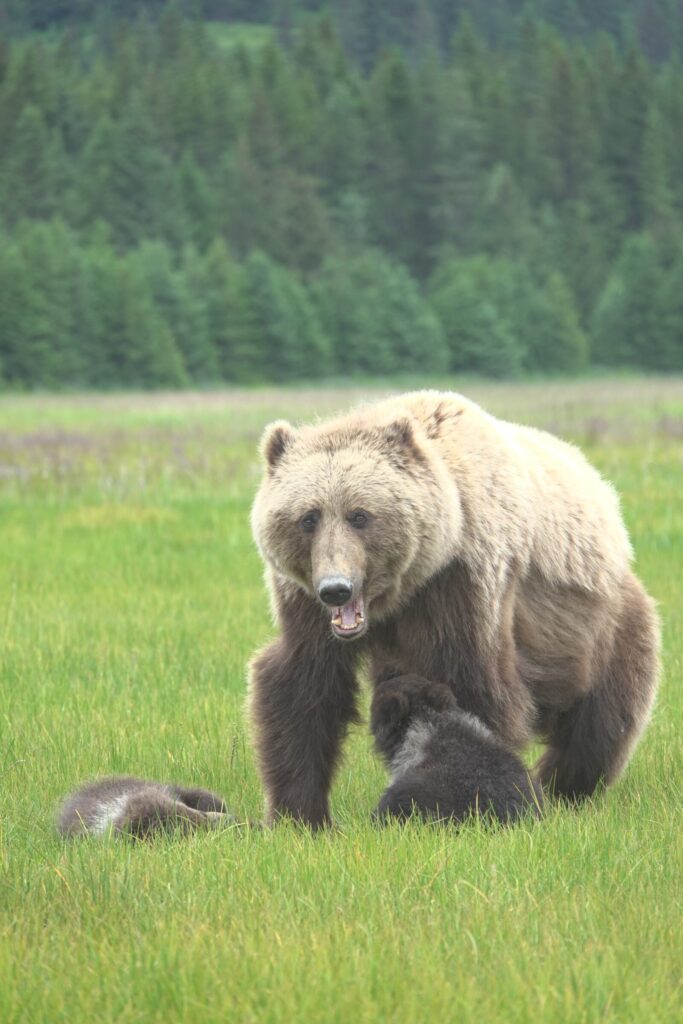
A photographer’s paradise: Why your pictures from Lake Clark will amaze your family and friends
Every photographer is different with regards to what they want to capture but you can say that they will all benefit from a location that offers a wide variety of landscapes, and continuously changing light conditions – that in a nutshell is what you will have when staying at Alaska Homestead Lodge. We get around on ATV with trailers that sometimes involve some exciting river crossing and stopping for an unexpected ‘bear crossing’ and if you drive direct from the lodge to the beaches where the brown bears spend hours clamming, you will pass through three very different habitats, from vast open sedge grass meadows, to sand dunes full of flowers and then ever changing tidal mud flats which pick up all the reflections from the bears and the changing skies – Magical!
Like many animals, bears are creatures of habit, so your superb private bear guide will know their daily routine and how they ‘journey’ through these different habitats. It is never about ‘chasing bears’, but always thinking ahead about where the bear will arrive as they forage through the landscape. There are preferred river crossing that mum likes to take her two cubs through and favourite trees that the large male bears like to scratch on. With this ‘inside’ information we can try to stay one step ahead of the bears and be in a perfect position to capture some amazing images.
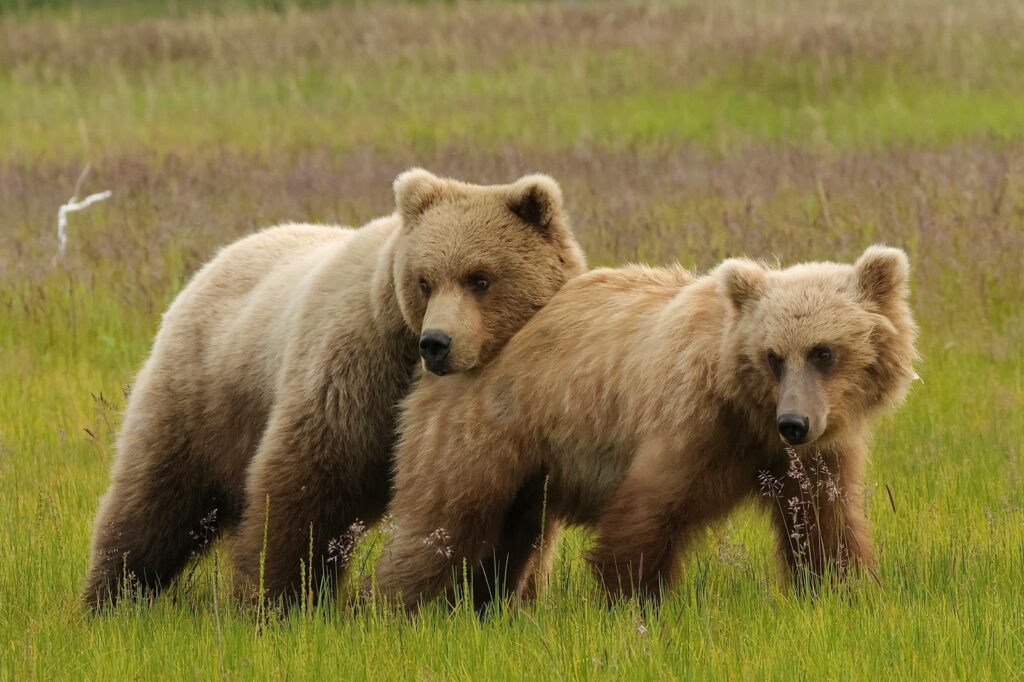
Photo Credit: K Timms
Why I became a bear clamming addict?
A few days into our stay at Alaska Homestead Lodge it became a bit of a running joke about how much I loved to head out to the tidal flats and watch bears clamming in the mud. Each bear has it own technique and some bears are much more efficient clammers than others which means their time while the tide is out, is much better spent than the amateurs still learning their trade.
Some bears rest on one shoulder while the other giant leg pushing deep into the mud to pull out the clams. Their eating technique is even more varied, with some showing a deftness of touch with their giant claws that is almost unbelievable to watch as they flick open the clams and suck out the contents. Whereas some simply smash the clams and then lick off the oozing mess from their paws to consume the calories in that way.
Many photographers, including myself, experiment a lot with low level shots where your camera basically rests on the ground, and you try to position the clamming bear on the horizon – ideally with a nice reflection in front of the bears and a stunning orange sky in the background. The images I obtained were a little bit hit and miss, but I do love a beautiful brown bear silhouette on the Lake Clark tidal flats and if there are two little cubs watching mum then that makes it even more special.
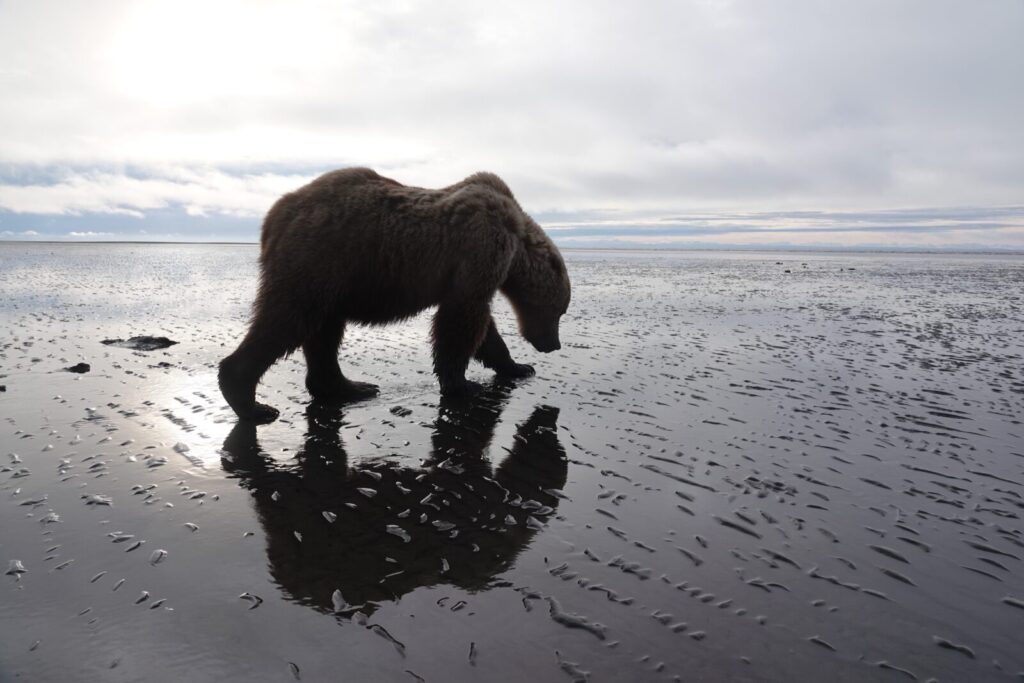
Why June and early July may be a better time to visit Lake Clark than the salmon season?
So, I am having a conversation with Brooke our guide about the salmon run in 2024. Most of the Alaska Bear lodges you visit have different seasons built around bear viewing but by far the most popular is visiting to see bears catching salmon. There are 5 different species of Pacific salmon and each one of them will arrive back in the rivers and estuaries at different times of the Alaskan summer. As a rule, peak activity for the salmon run season is from late July to early September and that is when the lodges will be at their busiest.
But what happens when the salmon ‘don’t run’ or arrive in such small numbers – as was the case in 2024 – that there are hardly any bears on the river? When first and foremost it is incredibly sad for the bears who are relying on those returning salmon to bulk up in late summer/early autumn before they head to their dens to hibernate. It also puts huge pressure on the wildlife guides at the lodges as their guests are expecting to head out to favourite bear ‘fishing spots’ each day and see brown bears catching salmon for fun.
When you consider the hit and miss nature of all global salmon runs in recent years, and I am not going to go into the many reasons for that in this blog, it makes sense to take this into account when planning your Alaska bear tour and look at the season as a whole and what may be better for more consistent bear sightings and amazing photography opportunities. We had already promoted the earlier June to July season to focus on mother and cubs but when considering all the above there is now even more reason to travel to Alaska earlier in the year.
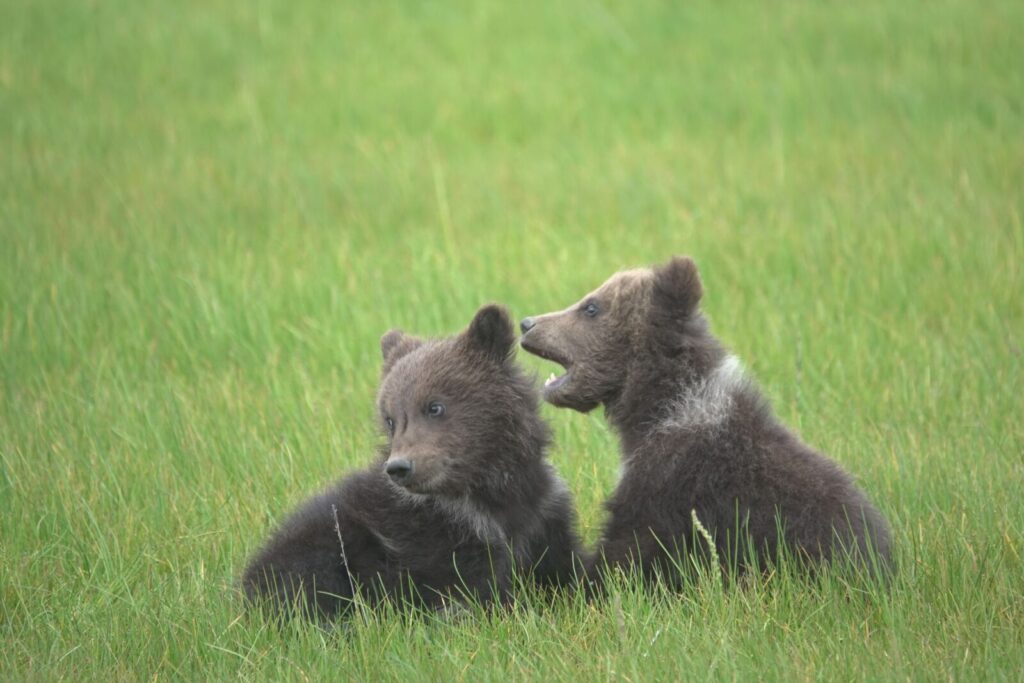
Kenai Fjords wildlife tour – why paying more for a small boat reaps huge dividends.
We are huge fans of the wildlife potential for a road trip down to the Kenai Peninsula. You only have to drive 30 minutes from downtown Anchorage to find yourself in the stunning mountain and fjord like majesty of the Turnagain Arm – Alaska Route 1 must be one of the most spectacular roads in the entire US. Our Alaska safaris link up three beautiful and very different coastal communities, Seward, Homer and Kenai – booking the very best Alaska bear viewing and marine wildlife specialists at each location which have all been road tested by us.
Seward is the main hub for Kenai Fjords boat cruises and the majority of the companies service the cruise boats and large tour groups so as you would expect they are large boats! That’s not for us here at Wildlife Trails so we book our guests onto a small well equipped motor cruiser with a maximum capacity of 6. We were just 5 when we headed out in mid-July 2025. It’s not just about avoiding the crowds, although that definitely helps, we also depart from Seward earlier and that means we get to the incredible glaciers before the ‘big boys’ arrive giving our group a more intimate and special view of these huge ‘walls’ of blue ice and the chance to see them calving. Even though our cruise was focused on wildlife you cannot help being impressed by the vastness of these glaciers, with some of them having ice walls 100M in height. The calving ice provides mini-icebergs for the harbour seals and that in itself is a great photo to take. For the more adventurous of you we would suggest booking a kayaking trip so you can gently paddle through the ice fields.
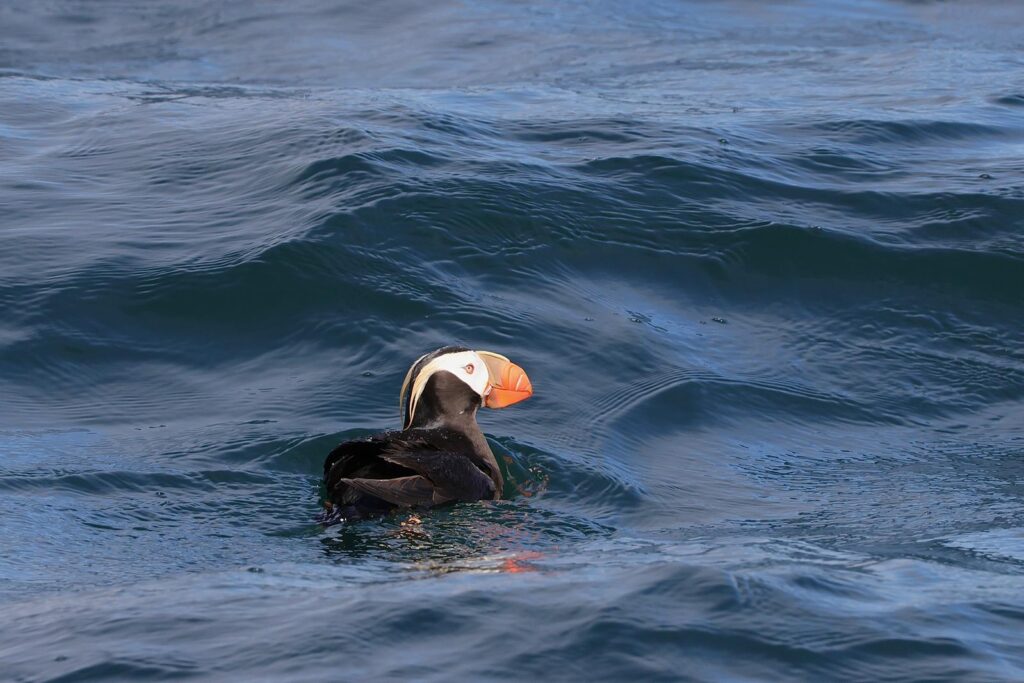
Photo Credit: K Timms
Why you are going to love Homer bear viewing tours
First things first, as you reach literally the ‘end of the road’ and arrive in your vehicle at the steep hill which marks the entrance to the town of Homer you will get your first views of the stunning Kachemak Bay. This will be your play area for the next few days and what an amazingly rich and beautiful ecosystem it is. We highly recommend booking accommodation with a view of the bay and keep your eyes open for Moose (common here) and the migratory Sandhill Cranes. Pretty much everything in Homer is focused on fishing and bear viewing and you have some amazing options to choose from.
Personally, we always take the Seldovia cruise, because it is one of the best places in the whole of Alaska to see rafts of Sea Otters (better than Seward!) and it is just an amazing day on the water combined with a visit to a genuine waterside ‘old timer’ community that with the bonus of nice weather will give you one of your best days on the peninsula.
Homer bear viewing tours have the big advantage of being closer to world class bear watching sites like Brooks Falls. Not only that, but the scenery also you will experience as you fly across the Cook Inlet will take your breath away. Brooks Falls and Lake Clark bear viewing tours are the most popular but there are other amazing locations to choose from, like Funnel Creek, where you get thrown a pair of waders and head out to see the brown bears up close and personal.
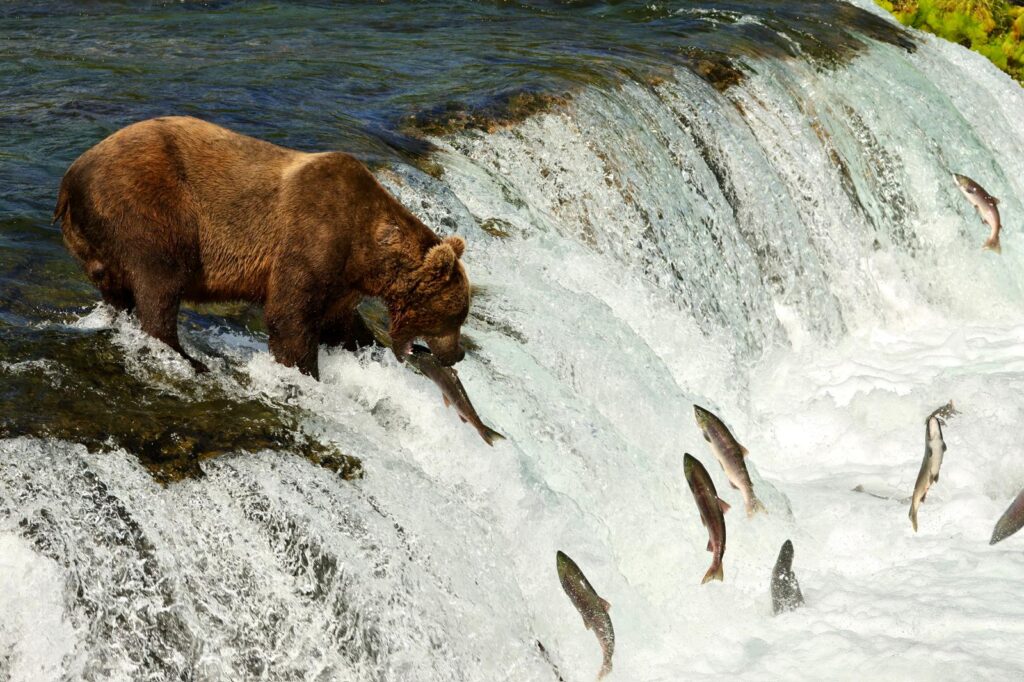
Photo Credit: K Timms
Bear viewing Kenai Peninsula: Why you should stay in the town of Kenai for Wolverine Creek bear viewing
The rich blue colour of the Kenai River is a spectacular sight by itself, let alone the hundreds of boats and anglers on the river in the summer fishing for salmon. I will always remember the first crossing of the Kenai shortly after you take the Highway south towards Homer. It’s simply stunning, and a sharp contrast to the denuded forests along the highway which have in recent years been infested by the Larch Beetle. Because the trees die, they are then more susceptible to forest fires.
The bustling town of Kenai can be divided into two main areas, new town and old town. The old heritage part of town is small and easily walked, and you will find a few restored original pioneer cabins and a couple of pretty Russian Orthodox churches. There is a short trail to the beach, where you can witness hundreds of locals pole ‘netting’ salmon to put into their cool boxes and then freeze them for eating in the autumn. It’s quite a spectacular sight, with salmon skins and carcasses everywhere and barbecues on the beach.
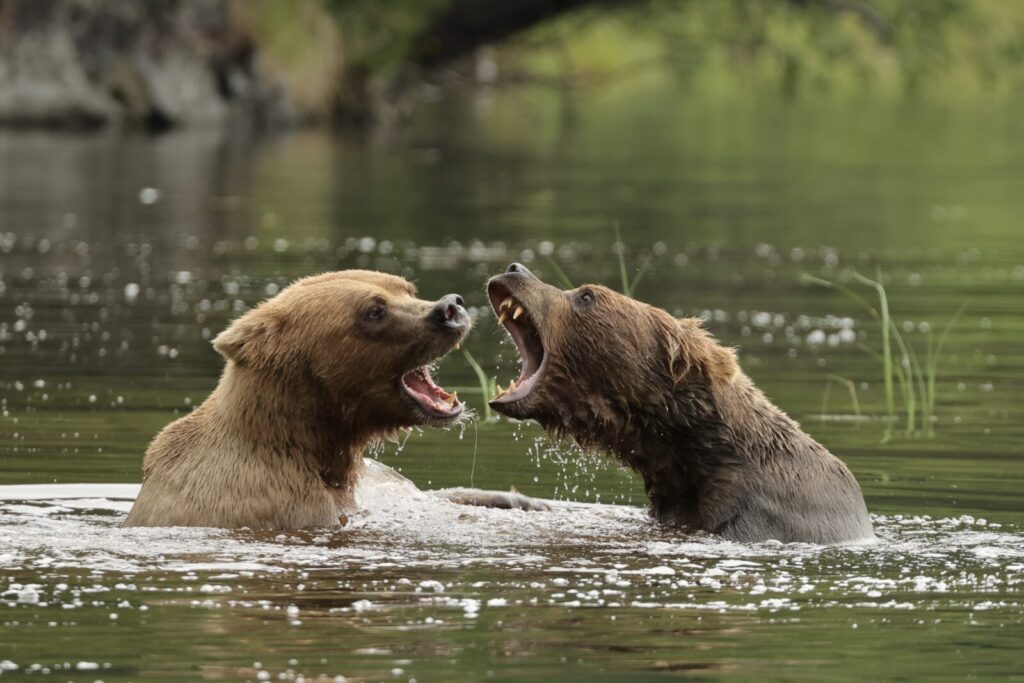
Wolverine Creek Bear Viewing: Where fishing and bears come together?
Wolverine Creek is just a short boat journey from Redoubt Bay Lodge, but we prefer to do it as a day trip with Alaska West air tours as that saves a lot of money. A very professional and well-priced bear viewing outfit who operate out of Nikiski, just a short drive from your accommodation in Kenai. Alaska Air have a large modern fleet of floatplanes at their base, and it is just a short 30-minute flight to the lake close to both the lodge and Wolverine Creek.
The focus for the Wolverine Creek bear viewing is a rocky river entrance to one of the inlets where both bear viewing boats and fisherman position themselves in the same location, but with different objectives. Although, judging by how many fishermen reached for their phones when a female bear arrived with two cubs clearly showed they were happy to enjoy both experiences!
We had an amazing bear viewing experience but the actual spot by the creek was not at its best because of lack of rains which meant the fish could not get up the river and all the salmon fishermen were concentrated in one spot; which was also where we wanted to be as photographers to get the best shots as the mother and cubs came down from the creek. There are still plenty of fish around for the bears (and ripening berries in the surrounding forest!), they just need to adopt a different technique to catch them. Believe me, watching an adult brown bears ‘snorkelling’ for salmon is a very cool animal behaviour to observe.
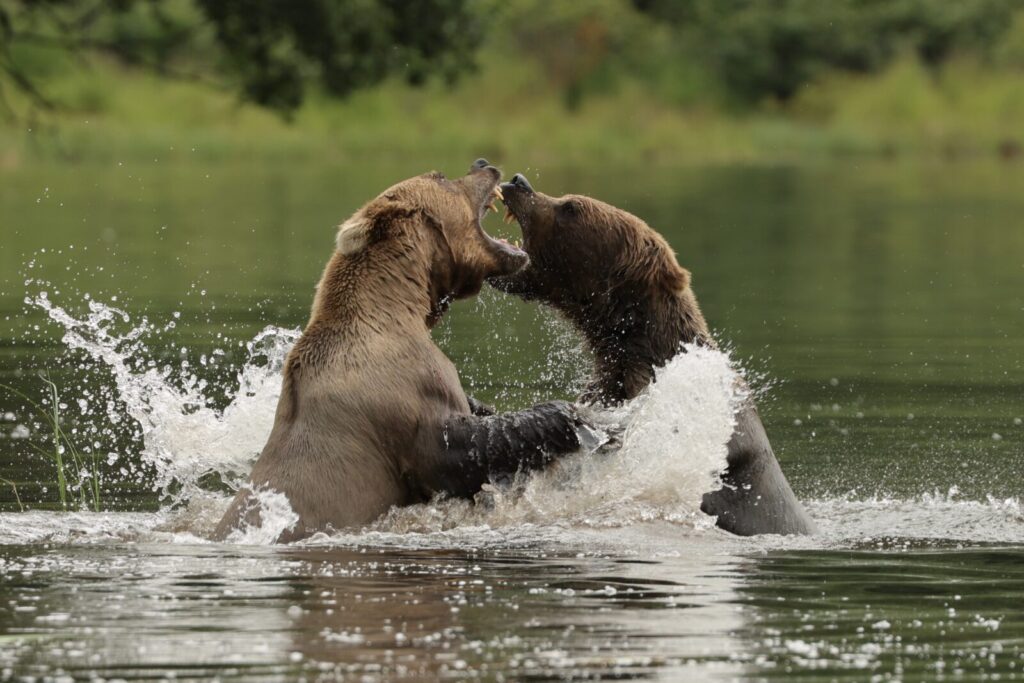
Wildlife Trails has some incredible Alaska bear tours planned for 2026 and 2027 with visit to Alaska Homestead Lodge, Brooks Falls and the incredible Katmai wilderness lodge, which is due to re-open in 2027. Our groups are always small and intimate with our own private guide and Allan coming along as tour leader and main driver to ensure we maximise our wildlife encounters at multiple locations.

